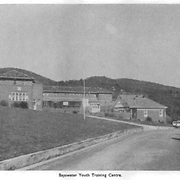
Bayswater Youth Training Centre, c. 1971
Details
The Juvenile Offenders Act 1887 formally separated the juvenile correction arm of child welfare from the provisions for so-called 'neglected' children. In practice, both parts of the colony's child welfare system were managed by the same office. The original intention of reformatories was to separate 'neglected' and 'criminal' children, but in practice reformatories were used for children considered to need stronger discipline than those directed to other types of institutions or to foster care. From the 1950s these types of institutions often became known as Youth Training Centres rather than reformatories, but the new name did not reflect a clear change in the role of these institutions. Beginning in the 1960s, deinstitutionalisation of child welfare caused fewer and fewer children to be sent to this type of institution. The renaming of the facilities as Juvenile Justice Centres in the 1990s reflected established changes - that the vast majority of children and young people under state control were not given custodial sentences and that this type of institution had more clearly become a youth arm of the criminal justice system.
Although Victorian child welfare legislation had technically drawn distinctions between children who were placed under state control because their parents were not equipped to retain guardianship and children who had committed crimes, children from the two categories were often placed side by side in institutions. Therefore, in practice, reformatories were used to control both children who had custodial sentences because of criminal convictions and children who had technically been charged as 'neglected' but who were considered to require firmer discipline than could be provided in other types of 'care'.
For almost a century, beginning in 1864, there were both state-run and privately-run reformatory institutions in Victoria. Initially, these were Catholic reformatories provided as an alternative to the state institutions because the church was concerned that Catholic children should have strong Catholic religious instruction. Around the end of the nineteenth century other voluntary religious organisations also became involved in running this type of institution. In the 1950s Reformatories were renamed Youth Training Centres, and the government took increased responsibility for running Youth Training Centres, rather than funding voluntary organisations to run them. In 1987 the government decided to entirely cease funding non-government bodies to run Youth Training Centres.
Commencing in the 1960s, and then accelerating through the 1970s and 1980s, deinstitutionalisation of Victorian child welfare promoted foster care, family group homes, and a range of other models of alternatives to large institutions. As a consequence, an increasing proportion of the children and young people in Youth Training Centres were serving custodial sentences for convictions, though a small number of children considered to be highly at risk of offending and therefore unsuitable for other types of 'care' were still placed there. In the 1990s these institutions were renamed Juvenile Justice Centres. By this time they were almost exclusively used for convicted or otherwise remanded young people over the age of 15. The name change in 2005 to Youth Justice Centres reflected little change in purpose. Victoria's Youth Training Centres were effectively a youth arm of the criminal justice system, however a 30 bed facility for young men aged 10 to 14 years on remand or sentence by the Children's Court to a Youth Residential Order remained at the Melbourne Youth Residential Centre.
1835 - 1850 Emergency Shelter: early colonial child welfare
1850 - 1977 Orphanages: the first institutions
1864 - 1887 Reformatories and Industrial Schools: the government enters child welfare
1874 - 1940 Boarding out: government reform of child welfare
1887 - Reformatories, Youth Training Centres, Juvenile Justice Centres and Youth Justice Centres: the government response to juvenile correction
Sources used to compile this entry: Musgrove, Nell, 'The Scars Remain': A Long History of Forgotten Australians and Children's Institutions, Australian Scholarly Publishing, Melbourne, in press.
Prepared by: Nell Musgrove
Created: 19 December 2012, Last modified: 4 October 2018